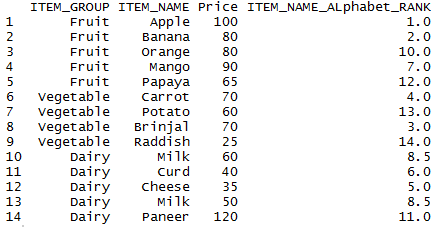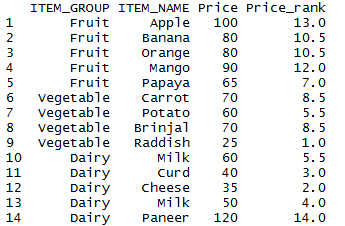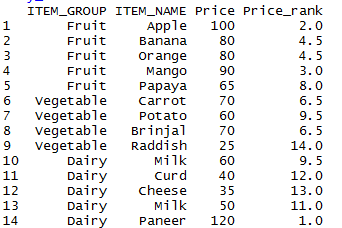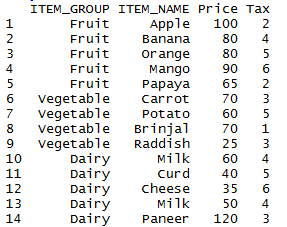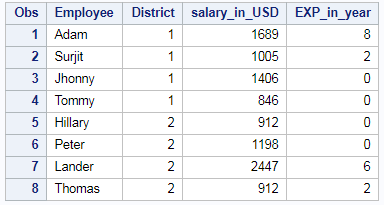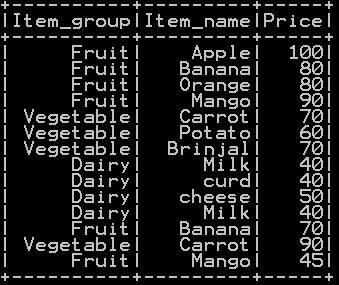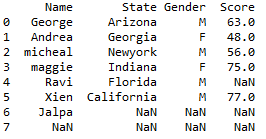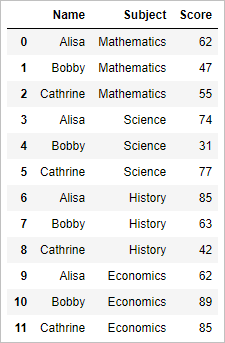rank() function in R returns the ranks of the values in a vector. rank function in R also handles Ties and missing values in several ways. Rank of the vector with NA. Min rank, Max rank, last rank and average rank in R. rank() function in R returns the rank of the column in R. We can also calculate minimum and maximum rank of the column in R dataframe.
- Rank the Vector in R by descending order, by minimum rank, maximum rank, first rank, last rank and average of two ranks if two values are found same
- Rank the dataframe in R by ascending and descending order
- Rank the dataframe column by minimum rank if found 2 values are same
- Rank the dataframe by Maximum rank if found 2 values are same
- Rank the dataframe column by first, last and average of two rank if found 2 values are same
- Rank the dataframe of the character column in R using rank() function.
Syntax for rank function in R:
| x | numeric, character or logical vector |
| na.last | Treatment of NAs. How to Handle NAs |
| ties.method | Treatment of Ties. How to Handle Ties |
Rank function in R with NAs as last:
x <- c(2,7,1,-17,NA,Inf,35,21) rank(x)
by default NAs are ranked last, so the output will be
Rank function in R with NAs as First:
NAs are ranked first
x <- c(2,7,1,-17,NA,Inf,35,21) rank(x,na.last = FALSE) #NA FIRST
output:
Rank function in R with NAs are removed:
NAs are neglectled by rank function
x <- c(2,7,1,-17,NA,Inf,35,21) rank(x,na.last = NA) #NA removed
output:
Rank a vector in R with NAs are ranked as NA:
NAs are kept and ranked as NAs by rank function
x <- c(2,7,1,-17,NA,Inf,35,21) rank(x,na.last = "keep") #NA is kept with rank NA
output:
Rank function in R with Ties=”Average”:
Average of the rank is allocated to the elements of vector when ties are encountered
x <- c(2,7,1,-17,NA,Inf,35,21,7) rank(x,na.last = TRUE,ties.method = "first")
output:
Rank function in R with Ties=”random”:
x <- c(2,7,1,-17,NA,Inf,35,21,7) rank(x,na.last = TRUE,ties.method = "random")
output:
Rank function in R with Ties=”max”:
Maximum value of the rank is allocated to the elements of vector when ties are encountered
x <- c(2,7,1,-17,NA,Inf,35,21,7) rank(x,na.last = TRUE,ties.method = "max")
output:
Rank function in R with Ties=”min”:
Minimum value of the rank is allocated to the elements of vector when ties are encountered
x <- c(2,7,1,-17,NA,Inf,35,21,7) rank(x,na.last = TRUE,ties.method = "min")
output:
Ranking of character vector in R:
Rank() function can also be used to rank character vector
y<-c("a","h","e","d")
rank(y)
output:
Rank the dataframe columns in R
First lets create the dataframe as shown below
#### Create dataframe
my_basket = data.frame(ITEM_GROUP = c("Fruit","Fruit","Fruit","Fruit","Fruit","Vegetable","Vegetable","Vegetable","Vegetable","Dairy","Dairy","Dairy","Dairy","Dairy"),
ITEM_NAME = c("Apple","Banana","Orange","Mango","Papaya","Carrot","Potato","Brinjal","Raddish","Milk","Curd","Cheese","Milk","Paneer"),
Price = c(100,80,80,90,65,70,60,70,25,60,40,35,50,120))
my_basket
so the resultant dataframe will be
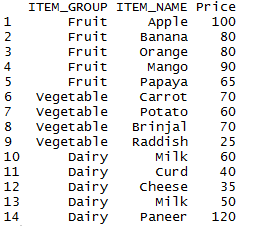
Rank the dataframe column in ascending order R
Rank of “Price” column in ascending order is calculated and assigned to the column “Price_rank”. in case of same values, average rank of both the values are assigned as shown below.
###### Rank the dataframe column in R my_basket$Price_rank = rank(my_basket$Price) my_basket
so the resultant dataframe with rank calculated will be
Rank the dataframe column in descending order R
Rank of “Price” column in desending order is calculated and assigned to the column “Price_rank”. in case of same values, average rank of both the values are assigned as shown below.
###### Rank the dataframe column in R my_basket$Price_rank = rank(desc(my_basket$Price)) my_basket
so the resultant dataframe with rank calculated will be
Rank the dataframe column in ascending order with random ranking method
Rank of “Price” column in ascending order is calculated and assigned to the column “Price_rank”. in case of same values, random rank of both the values are assigned as shown below.
###### Rank the dataframe column in R my_basket$Price_rank = rank(my_basket$Price,na.last = TRUE,ties.method = "random") my_basket
so the resultant dataframe with rank calculated will be
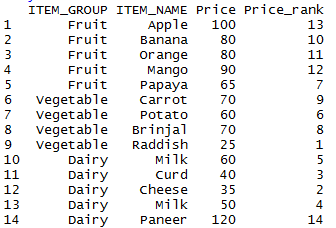
Rank the dataframe column in ascending order with max ranking method
Rank of “Price” column in ascending order is calculated and assigned to the column “Price_rank”. in case of same values, maximum rank of both the values in case of ties are assigned as shown below.
###### Rank the dataframe column in R my_basket$Price_rank = rank(my_basket$Price,na.last = TRUE,ties.method = "max") my_basket
so the resultant dataframe with rank calculated will be
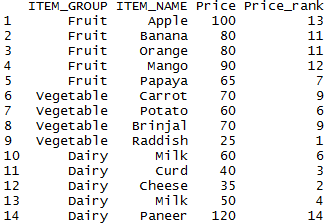
Rank the dataframe column in ascending order with min ranking method
Rank of “Price” column in ascending order is calculated and assigned to the column “Price_rank”. in case of same values, minimum rank of both the values in case of ties are assigned as shown below.
###### Rank the dataframe column in R my_basket$Price_rank = rank(my_basket$Price,na.last = TRUE,ties.method = "min") my_basket
so the resultant dataframe with rank calculated will be
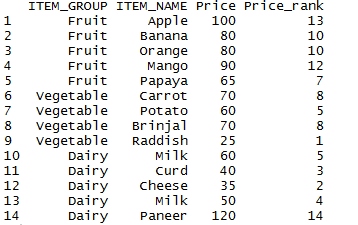
Rank the dataframe column in ascending order with First ranking method
Rank of “Price” column in ascending order is calculated and assigned to the column “Price_rank”. in case of same values, First rank is assigned to the first value in case of ties are assigned as shown below.
###### Rank the dataframe column in R my_basket$Price_rank = rank(my_basket$Price,na.last = TRUE,ties.method = "first") my_basket
so the resultant dataframe with rank calculated will be
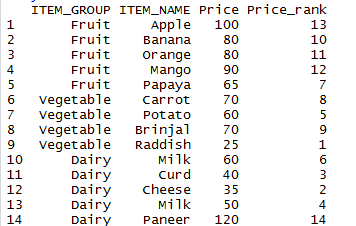
Rank the dataframe column in ascending order with last ranking method
Rank of “Price” column in ascending order is calculated and assigned to the column “Price_rank”. in case of same values, Last rank is assigned to the first value in case of ties are assigned as shown below.
###### Rank the dataframe column in R my_basket$Price_rank = rank(my_basket$Price,na.last = TRUE,ties.method = "last") my_basket
so the resultant dataframe with rank calculated will be
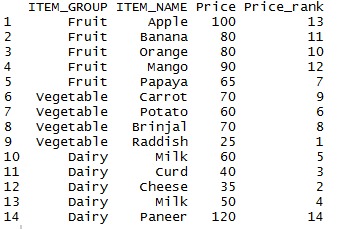
Rank the character column of the dataframe in R
Rank of “ITEM_NAME” column in ascending order is calculated and assigned to the column “ITEM_NAME_ALphabet_RANK”.
###### Rank the dataframe column in R my_basket$ITEM_NAME_ALphabet_RANK = rank(my_basket$ITEM_NAME) my_basket
so the resultant dataframe with rank calculated will be
